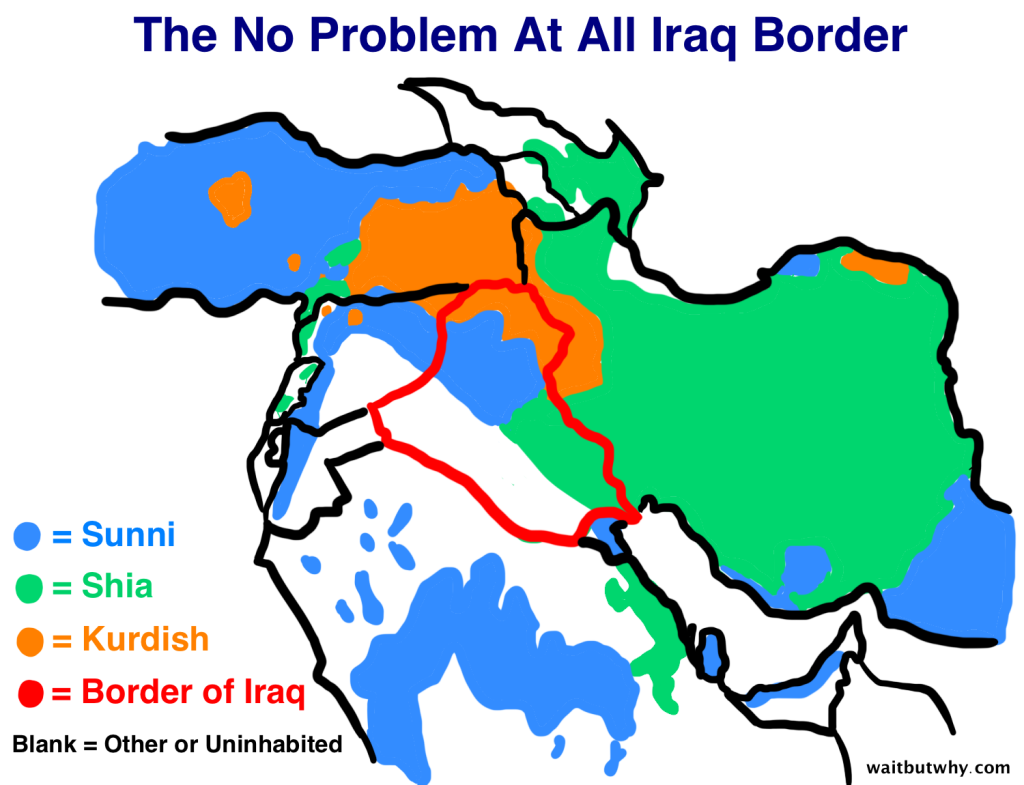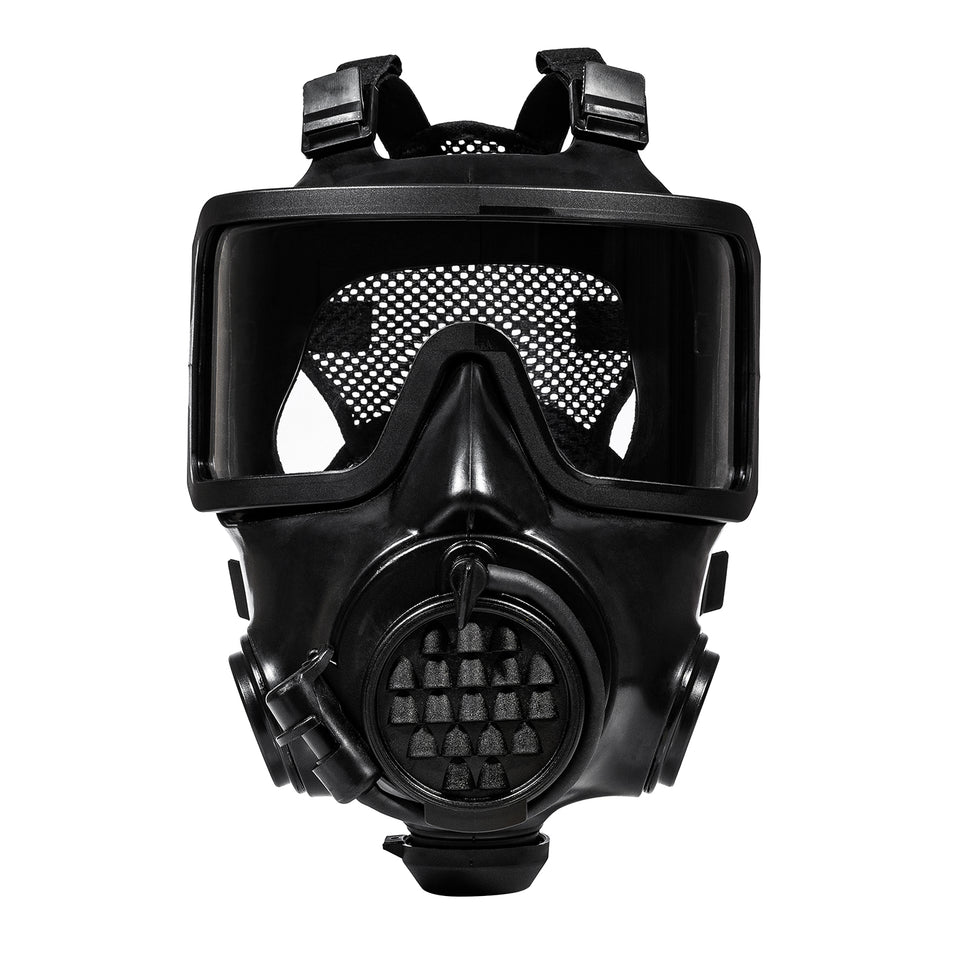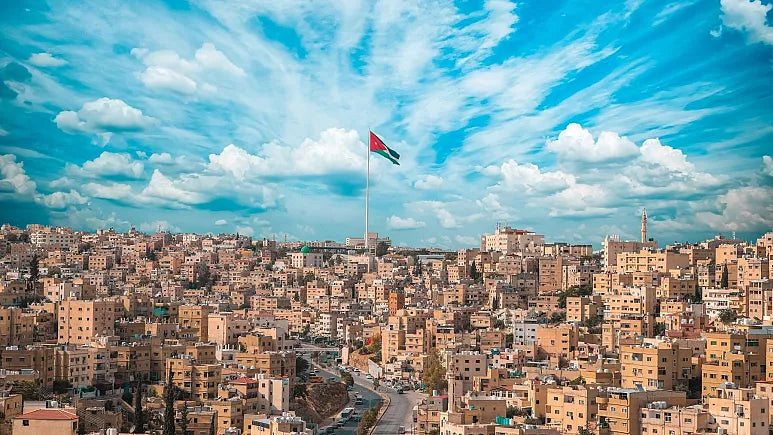In the midst of the escalating Israeli-Palestinian conflict, many onlookers are eagerly awaiting any and all glimpses of hope–a hint towards rapprochement for the region.
This past Saturday, Ayman Safadi, Jordan’s foreign minister, delivered an uplifting statement:
“There will be no Arab troops going to Gaza. None. We are not going to be seen as the enemy.”
Safadi claims all Arab governments have come to this agreement, and they’ll stand by it. While this may not mean Arab countries will have zero involvement in the conflict itself, it is still great news.
But, what is Jordan? While we’ve heard about King Abullah II of Jordan and his rousing speeches, most may be fairly ignorant about the country itself.
Moreso, many people may not know about the daring escapades of the King of Jordan, and how the country he led faced Islamic terrorism in much the same way the West did.
Lately, the royal family of Jordan has made headlines because of statements the Queen of Jordan, Rania Al Abdullahm, has made. While her vehement pro-Palestinian comments have raised eyebrows amongst some, Jordan remains committed to remaining as neutral as possible.
Let’s dive into the topic in much the same way the King of Jordan used to take princesses skydiving in his free time.
Table of Contents
-
01
Jordanian-Israeli Relations
-
02
His Majesty, King Abdullah II of Jordan
-
03
Her Majesty, Queen Rania of Jordan
-
04
Wait, but Why?
-
05
A Pattern Emerges
-
06
Black Friday is Approaching
-
07
Closing Court
-
08
Frequently Asked Questions

Map of Jordan. (Image courtesy of maps-of-the-world.com)
Jordanian-Israeli relations
Jordan, Israel’s neighbor to the east, has been involved in major political events since the end of the 1950s. After the ratification of its statehood in 1946, Jordan joined the United Nations and went on to ride hard for Palestine.
While Jordan retained control of the controversial West Bank following the end of the 1948 Arab-Israeli war, it relinquished control of the territory to Israel in 1967 after being defeated by Israel in the Six-Day War.
Following the Six-Day War, Jordan supported the Palestine Liberation Organization, or PLO, in its attempts to claim sovereignty in the now Israeli-controlled West Bank. However, Palestinian paramilitary elements called “The Fedayeen” began to rub Jordan the wrong way.
Of course, Jordan wanted to support their claim to the West Bank–but the Fedayeen had additional goals it wished to accomplish. As such, in September 1970, the Fedayeen hijacked three European aircraft at the Dawson’s field airport in Jordan.
After removing the passengers, the Fedayeen promptly blew up the aircraft. Understandably, Jordan had one question for the Fedayeen: “What the **** did that do to secure your claim to the West Bank? How did what you just did help you accomplish that?”
The Fedayeen responded with (paraphrased): “Well, we kinda feel like if we can overthrow a few governments, including yours, we’ll be able to liberate Palestine better.”
Unsurprisingly, the King of Jordan (King Hussein Bin Talal) decided the Fedayeen had to go. In what became known as Black September, Jordanian troops grabbed their proverbial brooms and performed a clean sweep of the entire country.
Syria, who once marched alongside Jordan into Israel in the Six-Day War, attempted to intervene in Jordan on behalf of the Fedayeen. This turned out to be an extremely regrettable decision for Syria, as Jordanian armored cavalry decimated their forces.
Then, in a curious turn of events, Israel also entered the fray, but on Jordan’s behalf. Jordan, fearing Iraqi intervention, turned to the international community and asked for backup, just in case Iraq did decide to make a move against them.
Israel, having no love for the Fedayeen, answered the call–putting aside their past transgressions. Israel then called upon the U.S. for support, fearing Russian intervention on behalf of their Syrian allies.
Once everyone was done calling their allies for backup–”Hey are you going to the war? Yeah I was going to go if you go? Okay cool”–the loose coalition was assembled.
The West, for its part, did not want this advantageous turn-of-events to be spoiled by Iraq or Russia. With their combined air superiority, Syria and the Fedayeen were expelled in 1971.
Shortly after the defeat, Syrian Air Force commander Hafez Al-Assad incited a coup, overthrowing Syria’s ruling government and installing himself as president. (His son, Bashar al-Assad, the current president of Syria, later came to power in 2000.)
Meanwhile, the scattered Fedayeen found a new home in Lebanon, where they supported the birth of Hezbollah. This conflict sowed the seeds of discontent in parts of the Arab world against Jordan.
All was not quite well between Jordan and Israel, however, as Jordan backtracked to partially support Syria during the Yom Kippur War (of 1973)–at least, that’s what they wanted it to look like.
This seemingly confusing move was solely to save face in the Arab world, as Jordanian units were instructed to stay out of the fighting, and Israel agreed to try their best not to attack Jordanian forces. At last, in 1994, Israel and Jordan signed a peace treaty to make their friendship Facebook official.
What followed was a period of peace between the two countries–almost. In 1997, a Palestinian bombing in Israel prompted the latter government to clap back. Along these lines, Israel targeted a prominent Hamas leader, Khaled Meshal, who just happened to reside in Jordan.
More specifically, Israel deployed two Mossad agents into Jordan to poison Meshal. When Jordan captured Israel’s agents, they demanded an antidote for the poison–threatening to annul their peace treaty. Bowing to international pressure, Israel acquiesced.
In 1999, King Abdullah II of Jordan ascended the throne, beginning his prestigious and distinguished rule. But who is the king of Jordan? What about his life and rule is so worthy of note?
King Abdullah II of Jordan, about to wreck ISIS’ whole operation. (Image courtesy of the Jordanian Government via Business Insider)
His Majesty, King Abdullah II of Jordan
King Abdullah II of Jordan is perhaps most well-known for his fiery and passionate response following the burning and murder of a Jordanian pilot, Moaz al-Kasasbeh, in 2015.
Sadly, this was not the first time Jordan had fallen victim to Islamic terrorism. Because of the aforementioned seeds of discontent sewn during Black September, many extremists considered Jordan a fair target.
In one notable example in 2005, the Jordanian people experienced what they came to call their “9/11”. In the Jordanian capital of Amman, Al-Qaeda launched a coordinated attack against three separate hotels in the city, resulting in the deaths of sixty citizens, and injuring 115 others.
This attack was carried out by an infamous terrorist known as Abu Musab al-Zarqawi. If that name sounds very familiar, that’s because al-Zarqawi is widely credited as the founder of ISIS–or rather, the spiritual inspiration for it.
The name al-Zarqawi is one that undoubtedly echoes in the king’s most troubled dreams. You see, at one point, al-Zarqawi was being held prisoner in a Jordanian prison. Merely six weeks into his reign, the king was presented with a list of names of prisoners to be released, including al-Zarqawi.
Jordanian tradition states that when a new king ascends the throne, the monarch is expected to deliver royal pardons to nonviolent or political criminals. Over 2,000 names were presented to the king in a royal decree of amnesty.
Unaware of the future repercussions, King Abdullah II–encumbered by the weight of tradition and the vastness of the list–signed the decree.
His decision, made in good faith, would later contrast sharply with his well-established military acumen as “The Warrior King.” In his storied career, he was a graduate of the British Military Academy, cobra attack helicopter pilot, tank commander, and the founder of Jordan’s Special Operations Command.
Indeed, the King of Jordan himself executed hundreds of drops as a front-line commando. Plus, the man was on Star Trek, and used to compete in professional rally driving. In short, he is the living embodiment of a Giga-Chad.
It’s easy to see, then, why he was overcome with righteous fury upon learning of Moaz al-Kasasbeh’s death at the hands of ISIS.
In 2014, al-Kasabeh’s F-16 was shot down. He was subsequently captured by ISIS militants, and used as leverage to secure the release of ISIS prisoners within Jordan.
Jordan, not wanting to repeat the mistakes of the past, turned this offer down.
ISIS then locked al-Kasabeh in a metal cage like an animal and burned him alive for the entire world to see. This was not only a cruel and barbaric murder, but also a grievous insult, as Islamic law declares cremation illegal.
King Abdullah was in Washington, D.C. attending a meeting when word of his pilot’s death struck him.
According to other officials at the meeting, King Abdullah launched into an epic tirade, declaring that his only concern was running out of fuel and bullets while pounding ISIS into the ground so hard they’d turn into glass along with the sand.
“The blood of martyr Moaz al-Kasasbeh will not be in vain and the response of Jordan and its army after what happened to our dear son will be severe–our response will be on the level of disaster.”
– King Abdullah II of Jordan
Upon returning to Jordan, King Abdullah promptly took the prisoner that ISIS was attempting to negotiate for, and publicly hanged him. He also executed another political prisoner accused of plotting to facilitate ISIS' infiltration into Jordan.
Following the public hanging, the king then personally visited al-Kasabeh’s family at their home, and promised bloody–brutal–vengeance for their son as fighter aircraft screamed overhead. He then put on a uniform, boarded a military aircraft, and rallied his military to rain death upon ISIS.
The allied coalition against ISIS agreed to let Jordan take the wheel, with the U.S. providing refueling and communications support.
With that, the Jordanian Air Force proceeded to obliterate targets in Syria, loosing a roaring decree: Do not come for Jordan–we protect our necks.
That right there is some heroic badassery. And it’s precisely why the U.S.–and everyone else–wants to keep Jordan as an ally. After all, would you want the king of Jordan on your bad side?
Of course, one could expect that such a man would marry a woman of equal magnitude, and he certainly did.

Her Majesty, Queen Rania of Jordan. (Image courtesy of the Jordanian Government via executive-bulletin.com)
Her Majesty, Queen Rania of Jordan
Queen Rania does not hail from prestigious royalty like her husband. Rather, Rania Al Abullah hails from a humble Palestinian refugee family. She is credited with wrangling down the wild and crazy Prince (at the time) Abdullah, who was widely known for his womanizing, racing, and extreme sports enthusiasm.
She had no idea she would one day become queen, as the line of succession called for the then King Hussein's brother to succeed him–not his son, Prince Abdullah.
However, King Hussein named Prince Abdullah as his successor on his deathbed, and two weeks later it was made so.
As queen, Rania has launched multiple aggressive initiatives to benefit the Jordanian people, and the world at large–from community and youth empowerment, to advocating for bridging the cultural divide regarding understanding, tolerance, and acceptance of religions and differences.
Between multiple charities, non-profits, and other various philanthropic endeavors, Queen Rania has shown the same–if not at times exceeded–her husband’s moxy for justice and fairness.
Her Youtube channel focuses on dispelling stereotypes about Arabs and Muslims, while also using her Twitter presence to conduct Q&A sessions for those who wish to hear directly from the queen herself about a variety of topics–including controversial ones.
Indeed, Queen Rania–not to be overshadowed by her husband, the king–has not shied away from making her thoughts known regarding the Israeli-Palestinian conflict.
While King Abdullah has voiced his support for a ceasefire, and has gone as far as claiming the displacement of Palestinians is a war crime, Rania is nowhere near as neutral.
In an interview with CNN, Queen Rania blasted the news agency for what she calls a double standard in coverage.
“It has been very disappointing to see the double standards in the world today, to see the strong condemnation of what happened on Oct. 7, but very little condemnation of what is happening today. Why isn't there a call for an immediate ceasefire?
We are seeing staggering human suffering happening today, so why is the narrative always skewed towards the Israeli side? The Western media and policymakers are quick to adopt the Israeli narratives. When Israel attacks, Palestinians ‘die,’ but when Israelis die, they are ‘killed,’ murdered in cold blood.”
– Queen Rania
While Queen Rania has made it clear that being pro-Palestinian does not equal being antisemetic, she has landed herself in hot water with the international community for making the argument that Israel is exaggerating Hamas’ atrocities.
While this statement’s intent is to push for independent verification of alleged war crimes before declaring they’ve been committed, it’s hard to not take her statements at face value.
After all, when a powerful queen makes a statement, the world listens.
It is perhaps statements like this that lend themselves to the history of misunderstandings in the region, leading to the instability we see now. Unfortunately for the rest of the world, when the Middle East becomes unstable, the world pays the price.
Notably, King Abdullah himself in his memoir recounts the time he spoke with President George W. Bush in 2002 regarding the invasion of Iraq:
“You are going to create a major problem in the Middle East. The problem is not with the United States removing Saddam–but what happens next?”
Multiple Arab leaders echoed this sentiment, asking, “What happens the day after you remove Saddam?” Well, as we know… removing Saddam created a vacuum of power in the region. And as we saw, there was no shortage of corrupt extremists hungry to fill that void.
Without a dictator or elected leader to control the region’s instability, Iraq spiraled out of control. The ensuing volatility dragged many countries into a long and painful war–one from which the region and the world have not fully recovered.
Now, faced with the Israeli-Palestinian conflict threatening to wear down any remaining goodwill from both enemies and allies, could we be looking at an explosive beginning to WWIII? Perhaps our path to rapprochement is merely the beginning of the path to hell: paved with good intentions.

Middle Eastern cultural areas vs drawn borders. (Image courtesy of waitbutwhy.com)
Wait, but Why?
The Middle East has long been one of the most unstable regions in the world. Before you nod your head in agreement and think: “Those countries have been at war for millenia!”, keep in mind why they’ve been at war–and that these countries have only existed for fewer than 100 years.
For further perspective, let’s acquaint ourselves with the Sykes-Picot agreement: one of the most baffling, frustrating, and least thought-out endeavors to ever occur. Following WWI, the allies were tasked with dividing up the Ottoman Empire. To recap, the Ottoman Empire had ruled for well over 600 years. 600 years, needless to say, is a lot of time for different regions to develop their own cultures, ideas, and traditions.
As such, dividing up the Ottoman Empire should have taken decades to figure out. It should have involved talking to tribal leaders, engaging with cultural and regional officials, and countless hours of carefully drawing borders so as to respect the long and storied traditions of the Middle East.
Undoubtedly, there were already plenty of understood and respected borders within the Ottoman Empire, formed by local populations based on ethnic and religious divisions, and demarcated by mountains, rivers, oceans and valleys. This is why many countries' borders are jagged and organically messy.
By contrast, you may notice that when looking at a map of the Middle East, everything seems like it was put together like a cheap puzzle.
Would you like to know why that is? The following is as brief as it is unbelievable:
One evening in 1916, a French guy named Georges-Picot, and an English guy named Mark Sykes grabbed a bottle of booze, a ruler, and a pencil, and started hammering everything out.
As seen in the picture at the beginning of this section, you’ll take careful note that the Sunni, Shia, and Kurdish areas of influence do not line up with the borders that Sykes and Picot drew.
This is because two guys got drunk and unwittingly doomed the entire damn world to eternal conflict by doing less than the bare minimum.
Awesome.
If only there was something that had happened previously they could have learned from! Hey, ya know, isn’t it funny how Africa kinda looks the same way? Like it’s put together funny?
Oh wait, that’s because in the late 1800s a bunch of Europeans held what was known as The Berlin Conference and did the same thing.
Curious how Africa is now also suffering the same fate as the Middle East, with wanton instability, violence, and terrorism.
So if low-effort redrawing of borders is a clear predictor of future conflict and instability, what does that mean for those of us on the outside looking in?
Graph showing multiple terror groups. Red bars indicate deaths caused by a group, yellow indicates injuries. (Image courtesy of Periscopic)
A Pattern Emerges
Instability in the Middle East has existed for a long time. If there’s no way to reasonably address the root cause of poorly conceived borders, religious differences, and 140 degree temperatures, what does it mean when the flames of conflict are flamed by explosive conflict like the kind we see now?
To say nothing of the COVID-19 pandemic and its aftermath, the Middle East has long demonstrated its ability to produce terrorism during times of instability.
When Israel invaded Lebanon in 1982 in response to Hezbollah’s provocations, a U.S. Marine Barracks in Beirut was attacked a year later, leaving over 300 dead.
During the Iran-Iraq War (1980-1988), Iraq deployed mustard and nerve agents against Iranian forces, resulting in over 1,000,000 casualties.
During the First Intifada (Palestinian uprising) in 1988, Iraqi warplanes bombed the Kurdish town of Halabja with mustard and nerve agents, killing over 5,000.
During the Second Intifada in 2000, with the region destabilized, Al-Qaeda militants were able to carry out an attack on the USS Cole in Yemen, leaving seventeen dead and forty injured.
Also during the Second Intifada, Saudi-backed terrorists hijacked four U.S. civilian airliners in September 2001. Two of the aircraft were flown into the World Trade Center in New York City, Another was flown into the Pentagon in Washington D.C, and the final aircraft was aimed at the U.S. Capitol building.
While the latter group of terrorists failed to complete their attack due to the bravery of those aboard the aircraft, which forced it to crash in a deserted field, the other three attacks resulted in the death of 2,977 victims. The number of those injured and affected is too substantial to be known.
As the Global War on Terror raged from 2001-2021, countless attacks can be attributed to the continued destabilization of the Middle East.
March 27th 2002: A suicide bomber kills twenty-nine and injures 140 during an attack on a hotel in Israel. Hamas claims responsibility.
July 7th 2005: Four suicide attacks on London’s public transport system. Fifty are killed, and over 700 are injured.
November 5th 2009: Nidal Hasan killed thirteen and injured thirty, Fort Hood, Texas. Hasan was in contact with Islamic extremists.
April 15th 2013: Three killed, 264 injured at the Boston Marathon bombing carried out by two radicalized Islamists.
April 2 2015: 147 killed in Kenya at Garissa University. Al-Shabab claims responsibility.
July 10th 2015: Boko Haram suicide bombing kills fifteen in N’Djama market, Chad.
November 13th 2015: A series of ISIS attacks in Paris sees 129 murdered and over 400 injured.
Unfortunately, this section is far from comprehensive, as a more in-depth timeline could fill an entire library. Regardless, there is a clear correlation between instability in the Middle East and worldwide terrorism.
So what do we do about it? How do we protect our own when the evidence says, “It could come back to our doorstep”?
Jordanian and U.S. Forces participate in Operational Eager Lion, an annual joint-training exercise. (Image courtesy of the Associated Press)
Black Friday is approaching
Keeping our ears to the ground and staying ready for anything is every savvy survivalist's credo. As the instability of the Middle Easts continues to grow, we can only hope that saner voices, like those of Jordan’s Royal family, prevail.
No matter where you land on the Israeli-Palestinian conflict, we can all hope that, ideally, the violence will end. Of course, the devil of how it ends is in the details, isn't it?
MIRA Safety is here to equip you, the educated reader, with the gear you need to stay safe and counter any threat.
With our Black Friday Sale LIVE NOW (up to 30% off!), there’s never been a better time to give yourself and yours the gift of safety.

MIRA Safety CM-8M Full-Face Respirator.
The MIRA Safety CM-8M Full-Face Respirator is MIRA Safety’s premiere gas mask. You’ve been waiting and asking for it, and now it’s back in stock! Don’t miss your chance to grab our latest generation gas mask. (They’re going quick!)
The CM-8M provides unparalleled protection and tactical compatibility, so you can remain safe and in the fight no matter what comes across your doorway. Specially constructed to grant a superior 92.5% field of vision and preserve compatibility with night vision goggles, rifle scopes, and thermal optics, this is a must-have mask for any kit.

CBRN Gas Mask Filter NBC-77 SOF.
The CBRN Gas Mask Filter NBC-77 SOF makes your CM-8M a bulwark of safety. Rated to the highest CBRN specifications, the NBC-77 SOF Filter keeps you protected against any and all CBRN agents. With a twenty-year shelf life, you can rest assured that you’re protected for years to come.

MIRA Safety MDG-1 Personal CBRN Decontamination Glove.
The MIRA Safety MDG-1 Personal CBRN Decontamination Glove rounds out your holiday shopping list with an essential addition to any survival bag. This lightweight and compact decontamination glove fits easily in any glove box, office desk, or your drop-knee pouch! Don’t find yourself without a means to decon your gear! Ensure your kit has the necessary essentials to stay alive and thrive.

His Majesty, King Abdullah II of Jordan looking dapper af. (Image courtesy of thenationalnews.com)
Closing court
In times of hardship and uncertainty, all of us need someone to look up to. For many, it’s a trusted authority or simply a leader we feel ourselves drawn to. King Abdullah II of Jordan, to this writer, encapsulates what a hero is.
Someone that doesn’t just talk about it–they are about it. Especially right now, with the Middle East burgeoning with chaos, it’s reassuring to know someone over there has their head on straight.
Straight, and on a swivel, is precisely how we all need to keep our heads at the moment. As we’ve discussed, instability leads to conflict. It may be outside of many of our scopes to change deep-seated geopolitical issues, but we can always control what is within our circle of influence.
With that in mind, it’s up to every one of us to ensure our families and friends are safe. By taking the proper steps to build an effective kit, stay educated, and train for the unknown, we’re doing just that.
This Thanksgiving, make sure to give thanks and gratitude to those around you. The ones who matter most, the ones who know us best, and the ones we’d do anything to protect.
Hold fast and plugged-in to the MIRA Safety blog for all your critical updates, and for holiday sales and offers.
And as always–stay savvy, survivalists.

KNo, really, he was in Star Trek. (Image courtesy Paramount/CBS via badassoftheweek.com)
